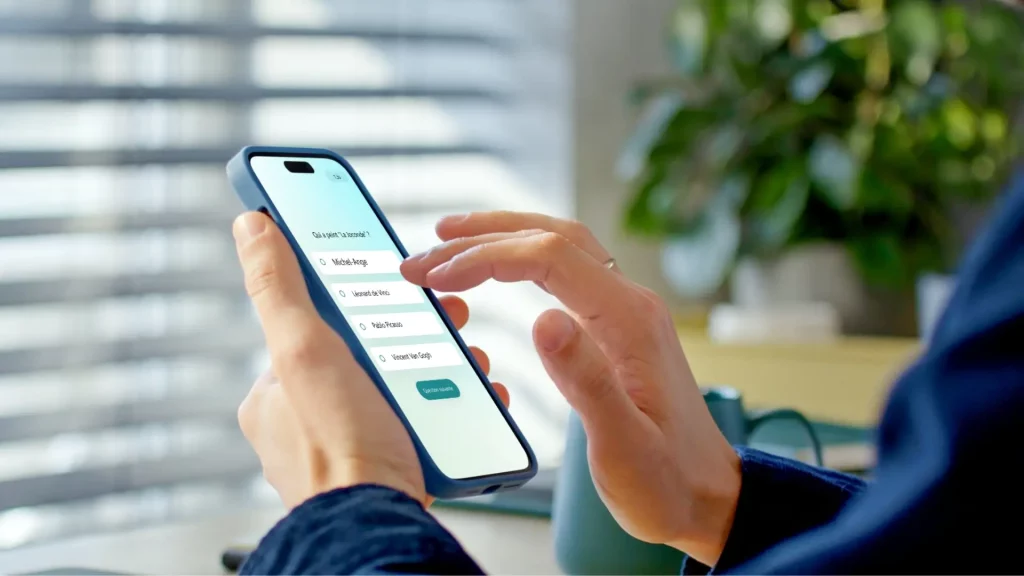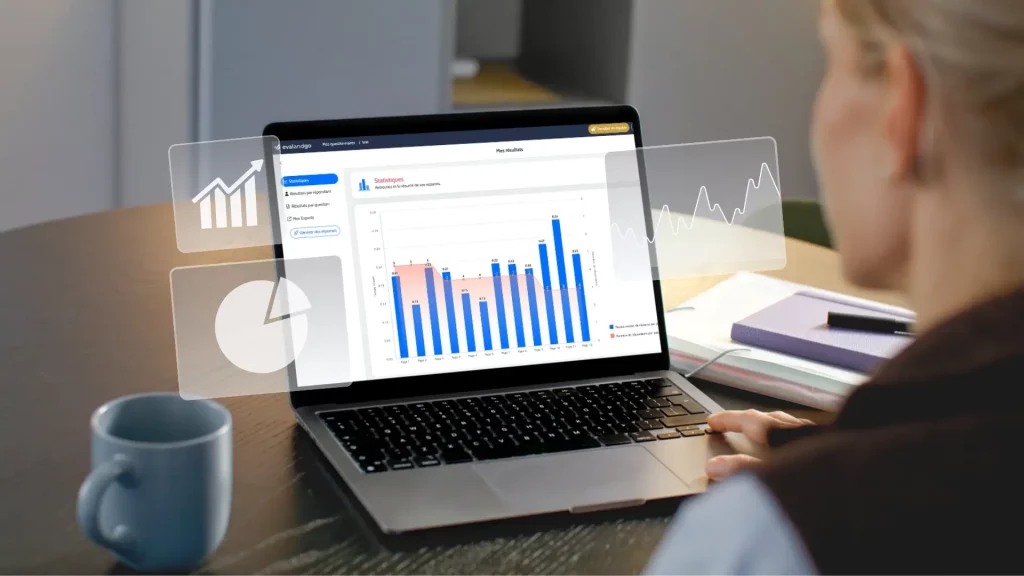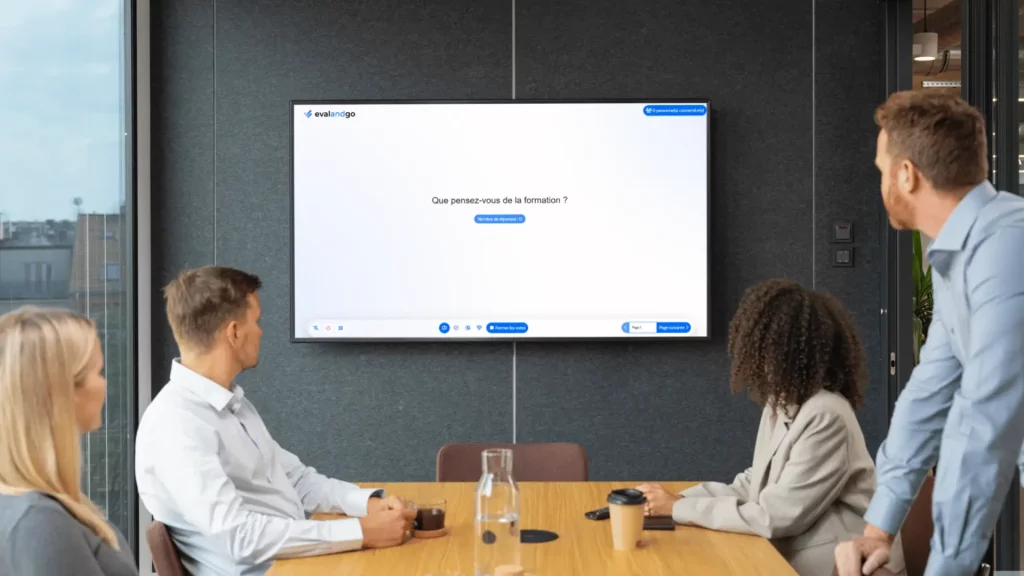Whether during a training session or a meeting, managers, trainers, and coaches face the same challenge: how to keep participants focused, engaged, and ensure they truly remember what matters?
Too often, sessions are one-way — the trainer speaks, the audience listens… and soon forgets. The result: engagement drops, retention declines, and the time and money invested lose part of their value.
Fortunately, there’s a concrete, science-backed, and easy-to-implement solution: the live interactive quiz, like Evalandgo’s Live Mode.
In this article, we explain why this approach works, how to integrate it into your meetings or training programs, and why it’s most effective when combined with hot and cold evaluations.
Why attention and memory drop quickly without interaction
In professional contexts — internal training, workshops, seminars, HR feedbacks, onboarding — several factors come into play: multitasking participants, long or overly frontal sessions, limited “active listening,” and few opportunities for interaction.
The result: attention fades, engagement weakens, and memory retention becomes shallow.
What neuroscience says about memory and attention

Our working memory is limited, and attention fluctuates naturally. For learning to stick, information must not only be transmitted — it must be activated. That means recalled, questioned, discussed.
Cognitive psychology studies (Roediger & Karpicke, 2006) have shown that even a simple test or recall of information significantly improves long-term retention — a mechanism known as the “testing effect.”
In other words, prompting participants to respond to a question helps them shift from a passive listening posture to an active learning one.
Passive learning VS active learning: A pedagogical turning point
In training and management, purely lecture-based formats are less effective than interactive ones. A large meta-analysis of 225 studies (Freeman et al., 2014) found that active learning increases exam performance by around 6% and cuts failure rates by half compared to traditional lectures.
For managers and trainers, the message is clear: build interactivity, participation, and engagement into every meeting or learning session. Otherwise, the time and money invested will yield lower returns.
Live Mode: Turning passive audiences into active learners
Evalandgo’s Live Mode enables trainers to create live quizzes and polls during sessions.
Trainers ask a question, participants answer in real time, and results appear instantly. This creates discussion, reflection, and engagement.

Energizing training through immediate participation
When participants actively respond — through live polls, quizzes, or online surveys — attention rises, and memory anchors. You break monotony, refocus attention, and increase the likelihood that information will be retained.
For managers and HR professionals, this means greater involvement, micro-moments of reflection, and opportunities to test understanding on the spot.
The power of instant feedback
Live quizzes offer immediate feedback: displaying responses, clarifying misunderstandings, and providing short explanations. This real-time adjustment process is what researchers call formative assessment.
Black & Wiliam’s study (1998) demonstrated that formative feedback substantially improves learning outcomes. In business, this means higher efficiency, faster skill development, and better return on training investment.
Building team cohesion and collective intelligence
Live quizzes go beyond individual learning — they create collective momentum.
During meetings, events, workshops or training sessions, seeing group results encourages participation, dialogue and inclusion.
For managers and team leaders, this approach strengthens team spirit, encourages workforce engagement, and nurtures a learning culture across the company.

The measurable benefits of live quizzes
Now that we’ve covered why and how, let’s look at what benefits live quizzes bring to professional environments.
Scientific evidence: the Testing Effect
In neuroscience and educational psychology, the testing effect refers to how actively recalling information — through a quiz, a poll, or a question — improves long-term retention compared to passively re-reading or listening.
For learning professionals, every quiz question becomes a cognitive anchor point, strengthening recall and understanding.
Professional implications of Active Learning
Research shows that active learning — including live quizzes and interactive exercises — not only improves memory retention but also enhances learners’ ability to apply knowledge in professional settings. For instance, the meta-analysis by Scott Freeman et al. (2014), covering 225 studies, found an average improvement of +0.47 standard deviations (around 6% higher exam performance) and a 1.5 times lower failure rate compared to traditional lecture-based training.
In practical terms, an employee trained through interactive methods will better retain key messages (procedures, sales techniques, new product information), acquire skills more quickly, and rely less on a “trainer-fixer” — becoming more autonomous. This translates into higher productivity, fewer mistakes, and a faster return on training investment, ultimately increasing the overall value of the training program.
Positive effects on motivation and satisfaction
Live interaction also boosts satisfaction and a sense of recognition.
When participants are invited to respond and see instant feedback, their engagement deepens. Active listening becomes real.
For HR departments, this also means gathering quantified and qualitative feedback on each training or meeting — a goldmine for continuous improvement.
Combine live quiz and cold evaluation with Evalandgo.
In today’s professional world, several challenges must be addressed: high employee turnover, frequent team renewals (especially in retail and FMCG), an ever-growing number of product lines and processes, the need for rapid upskilling, and regular training on new tools.
In this context, a single interactive quiz is not enough. It’s essential to implement a comprehensive, continuous, and measurable evaluation process — and that’s exactly what Evalandgo provides.
Hot evaluation: capturing immediate impressions
During a training session, the coach can use Live Mode to conduct a hot evaluation, aimed at measuring satisfaction, engagement, and perceived usefulness. It’s also possible to create a post-training hot evaluation survey to collect additional feedback and data.
This provides an initial insight into participants’ experience and immediate reactions. Moreover, creating hot evaluations is also a legal requirement for training centers as part of the Qualiopi certification process.
Cold evaluation: measuring knowledge retention and skill transfer
A few weeks after the training, an asynchronous questionnaire can be used to assess what has truly been remembered or acquired — this is known as the cold evaluation. One of the major challenges for companies today is measuring whether the skills developed during training are effectively retained over the medium and long term.
In sectors such as retail or FMCG, for instance, training teams on new product lines or promotions requires ensuring that the information remains usable over time. This delayed follow-up, through a cold evaluation questionnaire, helps identify areas where knowledge has faded, make necessary adjustments, and refresh learning when needed.
Developing a continuous training evaluation framework
For managers, coaches, and trainers, the challenge lies in building a comprehensive training evaluation framework that supports continuous improvement and measurable results:
Live Mode (interactive quizzes, real-time questions) to boost engagement and active listening during the training session.
Hot evaluation to measure participants’ perception, satisfaction, and engagement right after the training.
Cold evaluation to assess long-term knowledge retention. This can be done once or at several intervals to verify whether the information has been forgotten over time.
This three-step approach aligns with a quality-driven, ROI-focused training strategy, meeting current requirements in certification, upskilling, and talent development. It marks a shift from simple note-taking to a culture of feedback and continuous improvement.
It also enhances the perceived value of training, allowing teams to periodically refresh knowledge, identify areas that may require reinforcement, and maintain performance consistency over time.
Today, Evalandgo is the only platform offering this 360° approach, combining interactive quizzes—to promote active listening and engagement—with asynchronous evaluations (hot and cold) that make it possible to measure learning retention over time.
From live quizzes to a culture of feedback
Interactive quizzes and Live Mode sessions aren’t gimmicks — they’re powerful drivers of managerial and pedagogical transformation.
Rooted in neuroscience and learning science, they improve focus, motivation, and long-term retention.
For trainers, managers, and HR professionals, integrating Mode Live into your programs means more engaging sessions, better memorization, and a measurable impact on learning performance.
To go one step further: combining live engagement with asynchronous evaluations allows you to close the loop — measure satisfaction, reinforce learning, and manage training quality over time.


